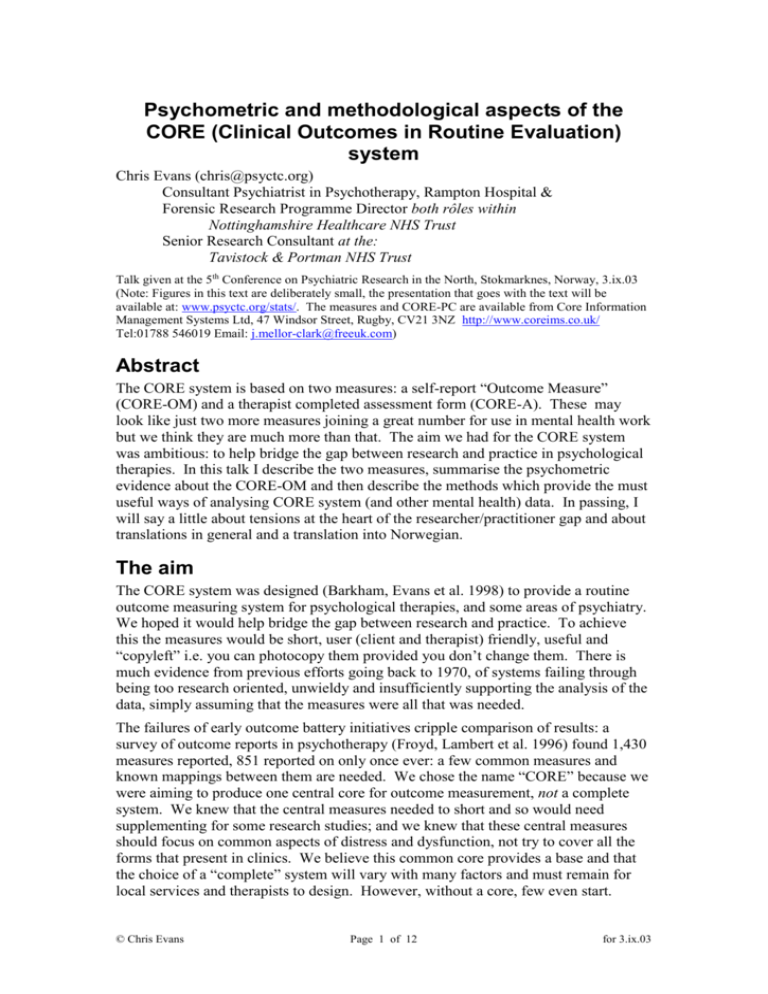Psychometric and methodological aspects of the CORE (Clinical
advertisement

Psychometric and methodological aspects of the CORE (Clinical Outcomes in Routine Evaluation) system Chris Evans (chris@psyctc.org) Consultant Psychiatrist in Psychotherapy, Rampton Hospital & Forensic Research Programme Director both rôles within Nottinghamshire Healthcare NHS Trust Senior Research Consultant at the: Tavistock & Portman NHS Trust Talk given at the 5th Conference on Psychiatric Research in the North, Stokmarknes, Norway, 3.ix.03 (Note: Figures in this text are deliberately small, the presentation that goes with the text will be available at: www.psyctc.org/stats/. The measures and CORE-PC are available from Core Information Management Systems Ltd, 47 Windsor Street, Rugby, CV21 3NZ http://www.coreims.co.uk/ Tel:01788 546019 Email: j.mellor-clark@freeuk.com) Abstract The CORE system is based on two measures: a self-report “Outcome Measure” (CORE-OM) and a therapist completed assessment form (CORE-A). These may look like just two more measures joining a great number for use in mental health work but we think they are much more than that. The aim we had for the CORE system was ambitious: to help bridge the gap between research and practice in psychological therapies. In this talk I describe the two measures, summarise the psychometric evidence about the CORE-OM and then describe the methods which provide the must useful ways of analysing CORE system (and other mental health) data. In passing, I will say a little about tensions at the heart of the researcher/practitioner gap and about translations in general and a translation into Norwegian. The aim The CORE system was designed (Barkham, Evans et al. 1998) to provide a routine outcome measuring system for psychological therapies, and some areas of psychiatry. We hoped it would help bridge the gap between research and practice. To achieve this the measures would be short, user (client and therapist) friendly, useful and “copyleft” i.e. you can photocopy them provided you don’t change them. There is much evidence from previous efforts going back to 1970, of systems failing through being too research oriented, unwieldy and insufficiently supporting the analysis of the data, simply assuming that the measures were all that was needed. The failures of early outcome battery initiatives cripple comparison of results: a survey of outcome reports in psychotherapy (Froyd, Lambert et al. 1996) found 1,430 measures reported, 851 reported on only once ever: a few common measures and known mappings between them are needed. We chose the name “CORE” because we were aiming to produce one central core for outcome measurement, not a complete system. We knew that the central measures needed to short and so would need supplementing for some research studies; and we knew that these central measures should focus on common aspects of distress and dysfunction, not try to cover all the forms that present in clinics. We believe this common core provides a base and that the choice of a “complete” system will vary with many factors and must remain for local services and therapists to design. However, without a core, few even start. © Chris Evans Page 1 of 12 for 3.ix.03 Psychometric and methodological aspects of the CORE system Lo c a l m e a sure s sc e de v i t a t li Qua CORE-OM CORE-A rt re p o r II f l e I-I o al s e nti e.g . BD r e f Re s, d sure a te RSD e a m r l H tia .g . n e re fe re s, e R su ea m rs rip to R m e fe e a re su ntia re s l e , e xt .g e rn .w a e ig l ht Figure 1. The "core" location of the CORE measures Our specific aims were that any CORE measures should: Be pragmatic and user-friendly Have acceptable psychometric properties Be used on a broad basis: “copyleft” Be both easy to score by hand and also computer-scannable Be supported by at least one co-ordinating centre Provide bases for extensions to other domains More specifically we wanted to achieve the following characteristics: CONTENT Short & legible Pan-theoretical Detect clinical change Good validity & reliability Sensitive to clients’ needs Relate input and output PROCESS Unobtrusive Minimum administration Easy to score Supported by clinical and non-clinical norms Easy to interpret UTILITY Aid assessment Enhance case management Provide inter-service comparison Enhance purchasing, planning & development Being “pantheoretical” is an ideal, not something you can entirely achieve. The development team1 included people from different professional backgrounds (psychology, psychiatry, counselling), theories (cognitive-behavioural, eclectic, psychodynamic, psychoanalytic, systemic, humanistic) and who worked in different service settings and geographical locations. We agreed that a measure broadly acceptable across theories and practices would have to measure domains of wellbeing, symptoms/problems and “functioning” (the components of the phase model of change in therapy); would have to cover inter- and intra-personal experiences; and would have to cover these areas within our criteria of short, acceptable etc. 1 The team has been led by myself and Professor Michael Barkham from Leeds, Dr. Frank Margison from Manchester has also been a founder member and with Michael and myself forms the three trustees of the charity who own the copyright on the measures. Others without whom the project would never have succeeded include: Janice Connell, John Mellor-Clark, Kerry Audin, Liz Benson, Graeme McGrath, Chris Marshall, Alex Curtis-Jenkins and many others, particularly members of the UK Society for Psychotherapy Research and its “SPR North Practice Research Network”. © Chris Evans Page 2 of 12 for 3.ix.03 Psychometric and methodological aspects of the CORE system The CORE-OM self-report measure The CORE-OM (see Evans, Mellor-Clark et al. 2000 for an introduction to the measure) resulted from extensive design work pilot testing with particular emphasis on it being easy to read. The measure has 34 items all with the same five level response and fits on two sides of A4, as shown overleaf. The measure covers the four domains mentioned above: well-being has four items; social functioning and problems/symptoms each have 12 items; and risk has six items of which three concern risk to self and three concern risk to others. One crucial aspect of the measure is that it is “copyleft”. That is, we, CORE System Trust, own the copyright and we will take legal action against anyone who changes the measure. However, we encourage anyone to copy it on paper provided that they don’t change it in any way nor make a profit from it. The measure is computer scannable and Leeds University’s Psychological Therapies Research Centre (PTRC) had offered batch scanning and reporting on the measure since 1997. In addition we license one company (CORE Information Management Systems) who sell a computer package that supports easy data entry and reporting. Figure 2. Page one of the CORE-OM These support measures, and the fact that the paper version can be photocopied without charge, mean the measure is now in widespread use. It was officially launched, with approval from the NHS, in 1998 when our pilot work had built a database of about 2,000 completions (890 clinical and 1,106 non-clinical); our databases of completed measures now contain over 20,000 entries and we imagine that over 30,000 copies if the measure have been used in English. Our initial studies (Evans, Connell et al. 2002) on n 2,000 showed: © Chris Evans Page 3 of 12 for 3.ix.03 Psychometric and methodological aspects of the CORE system Excellent completion rates and acceptability to native English speakers and to university students in Britain whose first language is not English; Very good internal and test-retest reliability; good convergent validity shown by clinical samples against the BDI-I and BDI-II, the BAI, BSI, SCL-90R, GHQ-28 and IIP-32; good convergent validity shown by large differences between clinical and nonclinical groups, and by sensitivity to change in short and longer therapies; good discriminant validity in negligible relationships with age from 16 to 80 and in highly significant but small effects of gender; The measure was intended to cover, but not to provide clear separation of, the domains of well-being, functioning, problems/symptoms and risk. We believe that these domains are often highly correlated. Our factor analyses (Evans, Connell et al. 2002) in both clinical and non-clinical samples, as expected, did not show a domain structure but suggested a three-factor structure on rotation of negatively keyed items, positively keyed items, and the risk items. A replication of the factor structure with 2,277 cases from a further clinical sample (Lyne, Evans et al. submitted) does not show the positive/negative factors separating clearly but shows the risk items largely distinct from the other items again. We encourage people to use the 28 non-risk item total as the best overall summary score and to look at the risk item scores as warning flags. We have published the psychometrics of the four domains as there is some evidence of differential change on them over time and as therapists sometimes wish to track a focal domain for a patient over the course of therapy. CORE-OM summary and translation We have achieved our design aim of an acceptable, quick, usable measure that people find useful. We now have a database of 9,300 clinical pre-therapy or first session completed forms that have been submitted for analysis through the PTRC batch processing route. In addition, 70 psychological therapy services in Britain currently purchase the CORE-PC computer system and we envisage that doubling the national database in the next six months. We are very keen that the CORE measures be translated for use in other languages but are aware that there a number of very bad translations of measures in the mental health field and also aware that translation has often been too literal and based on assumptions of cultural and linguistic invariance of psychological problems that are unrealistic. Hence we have strong but simple conditions for translation and insist on working with a local lead on translations and that the final text must be copyright to the CORE System Trust and hence copyleft, i.e. free for anyone to photocopy and use. Currently we have a certified translation into Gujarati and translation work underway on other languages including Italian, French Canadian, German and British Sign Language. Professor Vidje Hansen has been leading work with us on translating the CORE-OM into Norwegian and we hope that by the conference this translation will be entering field trials and accumulation of Norwegian referential data. When we have final translations, these will be incorporated into CORE-PC but Professor Hansen and colleagues are already experimenting with use of the English language version. If anyone wishes to discuss other “northern” translations, I would be very keen to talk with them during the rest of the conference. © Chris Evans Page 4 of 12 for 3.ix.03 Psychometric and methodological aspects of the CORE system The therapist completed form: CORE-A The CORE-A is not a therapist completed rating scale. It was designed on extensive feedback and field trials, to provide crucial information about clients/patients to profile the work of therapists and services, and to help interpret CORE-OM data. The CORE-A consists of two pages of A4. The first two sides, the “Therapy Assessment Form” (TAF) are completed after assessment. They cover: Demographics: gender, age, referral and contact dates, living situation; Clinical history: previous therapy and hospital care and current medication; Clinical state: problem and risk ratings, ICD-10 diagnoses and categories and actions clients have taken to date to help themselves; and The outcome of the assessment. Figure 3. CORE-A Therapy Assessment (TAF) Form The last two sides of the form are the “End of Therapy form” (EOT). These cover: Logistics of the therapy: sessions planned, attended and not attended, starting and ending dates; session frequency and if a follow-up appointment has been booked; Descriptors of the therapy: theory, modality (individual, group, couple, family) and mode of ending of therapy; Clinical state at termination: problems and risk (repeating that on the TAF) and a review of any benefits of therapy and changes in any medication; And finally information that many therapists said they wanted to record: motivation, working alliance and psychological mindedness. These categories come from the “practice” rather than the “research” side of the researcher/practitioner gap. Some variables, e.g. gender, age, dates, sessions, probably medication, are very reliable and valid. Some, e.g. ICD diagnoses, may be reasonably reliable and valid on the basis of therapists’ core trainings or with additional training that can be fairly easily provided for principle diagnoses and © Chris Evans Page 5 of 12 for 3.ix.03 Psychometric and methodological aspects of the CORE system categories using existing books and videotapes for the ICD. Finally, a last category of variables, e.g. problem severities and improvements, therapy theory, risk ratings and motivation, working alliance and psychological mindedness, in many ways the most interesting and important variables, cannot be assumed to have validity or even interrater reliability but can be of great local interest and allow development of trainings that could certify agreement to common standards of rating. Figure 4. CORE-A End of Therapy (EOT) Form The CORE-A is not amenable to psychometric analysis unless we or others chose to develop reliability and validity trainings for it. However, the reliable and face valid variables are crucial to help therapists or services compare their work and interpret their CORE-OM data which brings us to how to analyse CORE data usefully. Methodology for use of the CORE system We always knew (Barkham, Evans et al. 1998) that any outcome system needs support for processing if is to be useful and planned for the CORE-OM to be easily scored by hand but also compatible with computerised batch scanning and reporting (Evans, Connell et al. 2003, submitted) and we planned for locally computerised processing of data from entry to reporting (CORE-PC). We also knew that there would need to be a paradigm shift in how we decide what evidence is useful, to complement the efficacy driven “Evidence Based Practice” paradigm: what we call the paradigm of “Practice Based Evidence” (PBE: Margison, Barkham et al. 2000) coming from “Practice Research Networks” (Audin, Mellor-Clark et al. 1999). Working on these things made us realise we need to address methods of understanding and reporting of data if the practice/research gap is to be bridged – for practice become more “evidence based” and researchers start to be influenced by practice and by the experience of practitioners. Having introduced you to the measures in the system, I will now talk a little about these data analytic issues. © Chris Evans Page 6 of 12 for 3.ix.03 Psychometric and methodological aspects of the CORE system The central tension of psychotherapy research and the practice/research gap The heart of psychotherapy and psychiatry is a very personal encounter, generally between a distressed, dissatisfied person, perhaps potentially a dangerous person meeting with someone who makes a living trying to help. The pressures are for successful achievement of intimacy within strictly professional boundaries, on empathic inference of the state of mind of the patient; and to a large extent upon confidentiality. At the same time, therapists, if they are to succeed, must address and manage practical issues of timing, frequency, duration; of setting, fees or insurance or public health reimbursement. These practical issues, and their contrast with what is qualitative, idiographic2, personal and intimate, are not as well explored in the therapy literature as they should be. They are addressed to some extent particularly in the psychodynamic, analytic and, to lesser extents, the systemic and existential theories. If the tensions of managing the intimate and personal heart of the process and the practicalities are not well explored, far less has been written about the similar tensions therapies and research methods. The dominant research methods, though often described as psychological, have come from medical, biological and even agricultural or industrial quantitative traditions. Certainly there are vital and excellent qualitative research methods but these have hardly impinged on “evidence based practice”, nor, arguably, has all the quantitative research that much affected routine practice. In what follows I argue that quantitative research methods need to change direction if they are to help bridge the research/practice gap. Rather than prioritising efficacy RCTs addressing important but abstract and generalised questions like “does therapy X work?” in the pharmacology/agricultural paradigm, mental health research must also prioritise measurement of individual change and of individuality; and it must attend more to managerial practicality. One huge improvement already occurring is the move to complement efficacy RCTs with pragmatic RCTs and to address cost-effectiveness including cost offset over moderate to longer term follow-up. CORE is not central to these improvements but it can help if it achieves widespread use as an outcome measure in efficacy and pragmatic RCTs as that would maximise the likelihood that practitioners reading reports of such studies would know and understand reported scores3. However, I am going to address four other issues of methodology that seem of important to us as we address the best use of CORE system data. These are: Measurement of individual change, reliable and clinically significant change Use of simple confidence intervals to help indicate precision of all grouped data Use of graphical presentation of data Ability to “drill” or “zoom” back, down, in, up and out of data, taking account of its multilevel nature if not (yet) using formal multilevel inferential methods 2 Idiographic = unique descriptors of individuals not reducible to scores on scales on which we could all be scored. Contrasted with “nomothetic”: measurement that is on ubiquitous categories or scales. 3 I acknowledge that this sort of bridging has already been achieved in the CBT domain by the BDI and a number of other measures. However, since almost no measures are in genuinely widespread use in other modalities of therapy, and since most of the dominant CBT located measures are actually copyright and potentially costly, there is still a need here and one CORE could help fill. © Chris Evans Page 7 of 12 for 3.ix.03 Psychometric and methodological aspects of the CORE system One final method, again about measuring individuality, is “rigorous (or quantitative) idiography”: being able to put probabilities on the likelihoods of recognising idiographic and qualitative data. However this is not, yet, linked to the CORE system so I leave it here with just a reference to the first of a string of pertinent methods I think will emerge over the next decade: (Evans, Hughes et al. 2002). Measurement of individual change, reliable and clinically significant change (RCSC) These approaches to categorising test-retest change on dimensional measures go back to a mathematically incorrect paper by the late Neil Jacobson (Jacobson, Follette et al. 1986). That was corrected by (Christensen and Mendoza 1986) and the correction acknowledged by Jacobson et al. immediately (Jacobson, Follette et al. 1986) leaving us with two complementary ways of classifying individual change on a continuous measure as categorically important. The two complementary questions are: Is change “reliable”, i.e. greater than you would expect to occur 95% of the time based on the unreliability of repeated measurement with whatever measure you use? And, Is it “clinically significant” which is determined in three different ways: A: has the change taken the score 2 standard deviations from the clinical mean; B: has the change taken the score within 2 standard deviations of the non-clinical mean; and the best version, C: has the score moved across the crossing point of the clinical and non-clinical distributions? The methods are based on Gaussian distribution models and assumptions that are likely to be violated in mental health outcome measurement4. However, the same is true for many statistical methods we continue to use for group summary data such as ANCOVAs for change. There have been suggestions, generally not very helpful, to “correct” some of the problems but little simulation to explore the robustness of the methods or to produce the non-parametric extensions and analogues that might (or might not) be more robust than these simple methods. However, the great beauties of the methods are: Their logic, while not without simplifications, is understandable without great knowledge of mathematics or statistics; They can be fairly easily calculated (though here CORE-PC is enormously helpful and we are developing www based forms to help those who can’t yet afford CORE-PC); They produce a simple graphical presentation of outcome data; And on a computer, this lends itself to drilling down and other ways of seeing wood for trees and trees in the wood5. 4 Particularly the very dubious methods A and B proposed to define clinically significant change which should probably only be used in very exceptional circumstances in which referential clinical or nonclinical data is lacking. It’s a useful rule that if your choice of measures puts you in this situation you should either change measures, or ensure that the data you collect contributes to publishing the missing referential parameters. We have a very nice expression in English: “You can’t see the wood for the trees” to describe the situation in which it is difficult to see overall pattern because one is too close to, or in other ways, overloaded with information. 5 © Chris Evans Page 8 of 12 for 3.ix.03 Psychometric and methodological aspects of the CORE system Confidence intervals for all grouped data The RCSC methods give a standard, objective method of categorising individual change on any continuous measure. What about a standardised, objective way of understanding the precision and importance of any group summary parameter? There is no need to create anything new: confidence intervals do this perfectly. Again, some of the assumptions on which they are calculated if calculated on Gaussian models for means are likely to be violated. However, we already have extensive simulation studies and know the best methods for proportions and fairly simple and calculable methods for medians and differences of medians and other centiles exist so there is no real justification for continuing to use inappropriate Gaussian assumptions. 1389 315 286 69 102 135 102 98 165164 141 69 77 60 639300 430 62 168 448 4 532 1086 968 2021 1308 142 153 203173113 7 1823 387 1564 1805 203 950 1040 2 5 1819 1362 1379 1657 3008 1385 812 915 927 1496 1 932 75 329 80 1232 1744 100 % White/European referred 55 40 49 1087 101 690 60 128 51 20 40 % 323 0 Overall proportion = 91.1% Maximum = 100% Minimum = 52.9% Ratio, max:min = 1.89 Number "significantly" high 11 Number "significantly" low 5 Number "significantly" different 16 Services © Chris Evans Page 9 of 12 for 3.ix.03 Psychometric and methodological aspects of the CORE system Again, we have the beauty that confidence intervals lend themselves to graphical presentations of quite complex and multivariate datasets and to drilling, for example, the forest plot is now widely used to summarise meta-analyses of systematic reviews (Lewis and Clarke 2001). They are best if produced by computers, particularly if you want notched boxplots to give a full picture of distributions of continuous data. 60 50 40 30 20 10 0 Referral Assessment Pre-Therapy Discharge 6 Month Follow-Up Occasion We are working on www forms to compute confidence intervals and produce notched boxplots of any continuous measure against one or more categorical factors. Graphical presentation of data You have seen some graphics already. Another graphical convention that has come out of CORE-PC is the “traffic light” quartile. We have been very keen to avoid ranking or “star rating” of services but to find ways to give services a picture of how their data compares with that of other services using the same measures. % clients achieving clinical & reliable change % clients reaching planned ending for therapy % of clients accepted for therapy 1 1 1 100 90 80 70 60 50 40 30 20 10 0 % achieved by 9 similar services 100 100 90 90 80 80 70 70 60 60 50 50 40 40 30 30 20 20 10 10 0 0 % achieved by 9 similar services % achieved by 9 similar services Figure 5. "Traffic light” presentation of service benchmarks © Chris Evans Page 10 of 12 for 3.ix.03 Psychometric and methodological aspects of the CORE system Traffic lights show the quartiles of the distribution across comparable services. These early examples are based on just nine primary care services, the intervals will be more informative with the next iteration of the benchmarks in 2004. In addition we are planning to attach vertical whiskers to the service’s own value (the black horizontal line) so that the precision of estimation can be seen. For many of the benchmarks we have chosen, there are clear “good” and “bad” ends to the spectrum hence the colour coding, for some, there are not and four neutral colours are used. Ability to “drill” or “zoom” back, down, in, up and out Psychological therapy data are multilevel: items within measures; points in time, within a therapy; clients nested within therapists; therapists nested within services; services nested within localities, and organisations. The sheer complexity of this multilevel organisation is obvious to practitioners: they know that how they work may not be comparable with how someone else works or has to work. (We don’t have differences as great as those between private practice in Oslo and running a service for the Archangel!) Therapists’ knowledge of these issues fuels what is often defensive scepticism about using research findings in individual or local practice. One thing that helps us address multilevel complexity is familiarity, largely from the financial spreadsheet territory and news media, with the notion of “drilling down”. We find it useful to think of ten “levels”, not all nested ones, within the data: 1. Items within scaled measures, e.g. is someone only scoring on risk items? 2. Measures within battery of measures/descriptors 3. Occasions (sessions) within episodes 4. Episodes within sequence of episodes 5. Episodes/occasions within individuals 6. Therapists 7. Services 8. “Settings” (currently separated as primary care, student counselling, workplace counselling, secondary and tertiary services) 9. Locality (not yet developed, e.g. rural/urban) 10. Country (overlaps somewhat with language/culture and politics of service) It’s important to remember that measurement reliability and sample size may mean that analyses at earlier levels, though tempting, are prone to mislead. Managerial analyses at later levels, if not persecutory, may more precisely help quality improvement. At most of those “levels” it’s possible to distinguish a “movements” of focus: Drill in To a different variable or measure, e.g. to an item in scale Drill down To a person in a group of data Drill back/forward Keep “back/forward” chronological, particularly important not to forget drilling back to the referral processes Zoom out Take in context from other clients, therapists or services (depending on level at the time) Find nearest Give context to observations by finding other similar units at neighbours appropriate level, e.g. finding 30 similar clients from the entire dataset and considering their change over time Helicopter up Take in wider view in two contexts/dimensions, e.g. more clients and profile of change within clients over time Stand back Take in more context, e.g. referral policies, procedures, funding © Chris Evans Page 11 of 12 for 3.ix.03 Psychometric and methodological aspects of the CORE system Ultimately, the exciting statistical developments in multilevel models, inferential tests and confidence intervals appropriate for nested and for cross-classified multilevel data will become routine and they are moving steadily into psychotherapy research. However, at present these methods are so alien to many researchers, let alone to practitioners, that their use without spatial orientation metaphors, and without graphical presentations of the data on which the methods are applied, will widen the researcher/practitioner gap, not help close it. Conclusions Nothing in the above is specific to the CORE measures. However, we believe that the CORE system, extending from pencil and paper scoring of the CORE-OM to careful review by therapists within a practice research network linking a number of comparable services, all supported by using CORE-PC or batch processed data, provides a set of tools and a philosophy of data analysis that really can start to close the researcher/practitioner gap. Many of the tools are not new or borrowed from other areas, there is much yet to do, but I hope you will agree that it is an interesting area. References Audin, K., J. Mellor-Clark, M. Barkham, F. Margison, G. McGrath, S. Lewis, L. Cann, J. Duffy and G. Parry (1999). “Practice research networks for effective psychological therapies.” Journal of Mental Health 10(3): 241-251. Barkham, M., C. Evans, F. Margison, G. McGrath, J. Mellor-Clark, D. Milne and J. Connell (1998). “The rationale for developing and implementing core outcome batteries for routine use in service settings and psychotherapy outcome research.” Journal of Mental Health 7: 35-47. Christensen, L. and J. L. Mendoza (1986). “A method of assessing change in a single subject: an alteration of the RC index.” Behavior Therapy 17: 305-308. Evans, C., J. Connell, M. Barkham, F. Margison, G. McGrath, J. Mellor-Clark and K. Audin (2002). “Towards a standardised brief outcome measure: psychometric properties and utility of the CORE-OM.” British Journal of Psychiatry 180(1): 51-60. Evans, C., J. Connell, M. Barkham, C. Marshall and J. Mellor-Clark (2003 (submitted)). “PracticeBased Evidence: benchmarking NHS primary care counselling services at national and local levels.” Clinical Psychology & Psychotherapy. Evans, C., J. Hughes and J. Houston (2002). “Significance testing the validity of ideographic methods: a little derangement goes a long way.” British Journal of Mathematical and Statistical Psychology 55(2): 385-390. Evans, C., J. Mellor-Clark, F. Margison, M. Barkham, K. Audin, J. Connell and G. McGrath (2000). “CORE: Clinical Outcomes in Routine Evaluation.” Journal of Mental Health 9(3): 247-255. Froyd, J. E., M. J. Lambert and J. D. Froyd (1996). “A review of practices of psychotherapy outcome measurement.” Journal of Mental Health 5(1): 11-15. Jacobson, N. S., W. C. Follette and D. Revenstorf (1986). “Towards a standard definition of clinically significant change.” Behavior Therapy 17: 308-311. Lewis, S. and M. Clarke (2001). “Forest plots: trying to see the wood and the trees.” British Medical Journal 322(7300): 1479-1480. Lyne, K. D., C. Evans, M. Barkham and P. Barrett (submitted iii.03). “Dimensions of variation on the CORE-OM.” British journal of clinical psychology. Margison, F. R., M. Barkham, C. Evans, G. McGrath, J. Mellor-Clark, K. Audin and J. Connell (2000). “Measurement and psychotherapy: Evidence-based practice and practice-based evidence.” British Journal of Psychiatry 177(August): 123-130. © Chris Evans Page 12 of 12 for 3.ix.03







